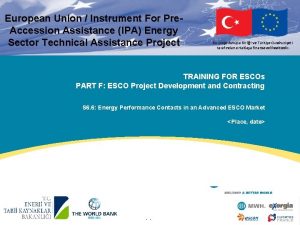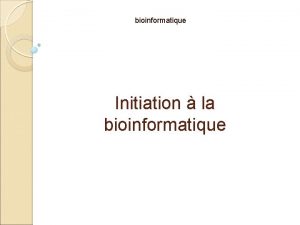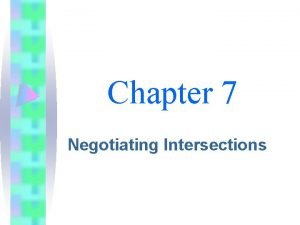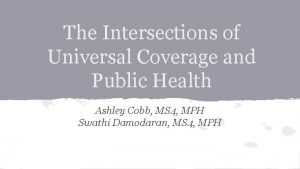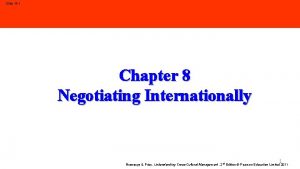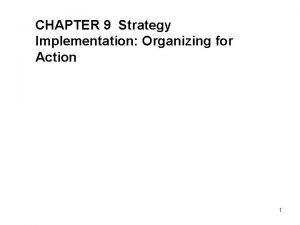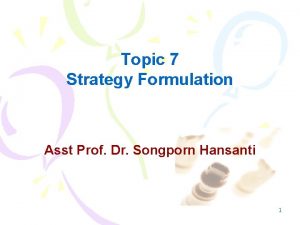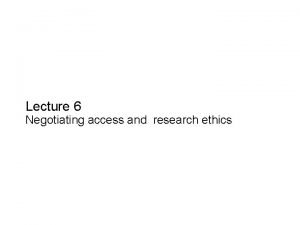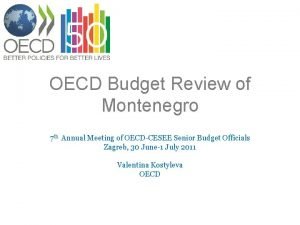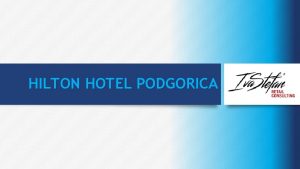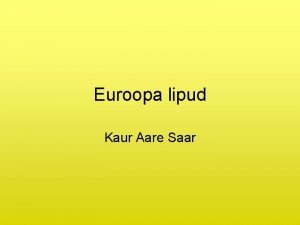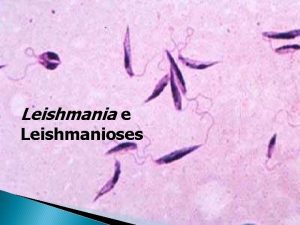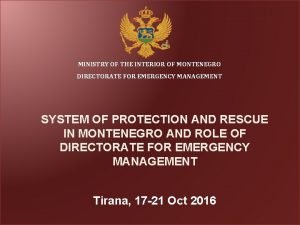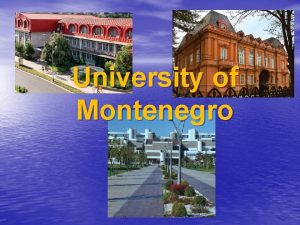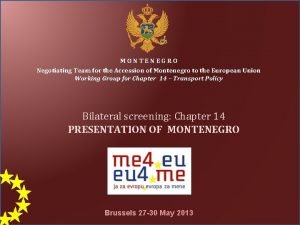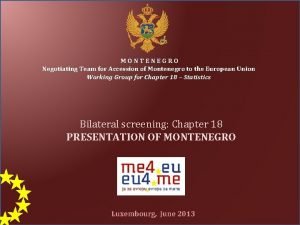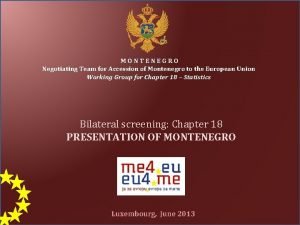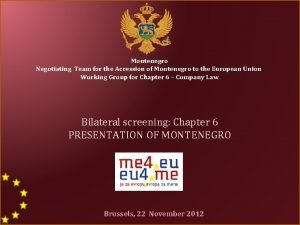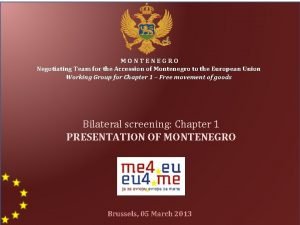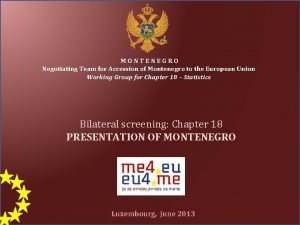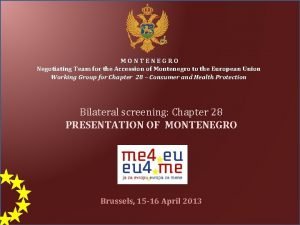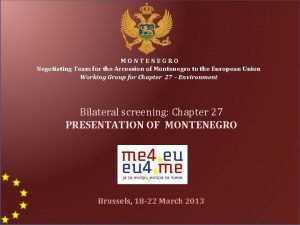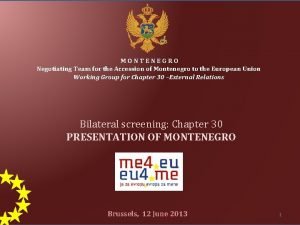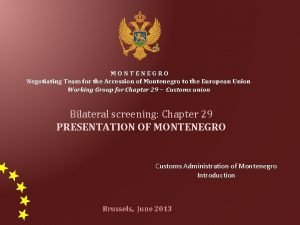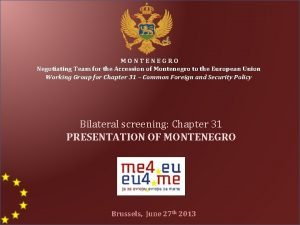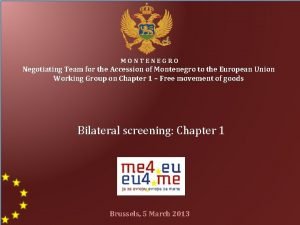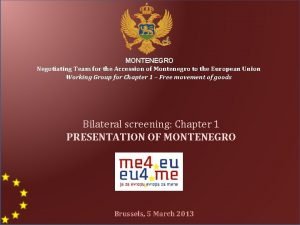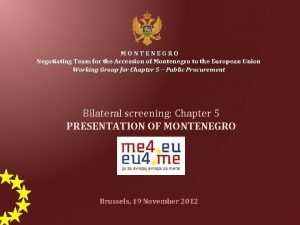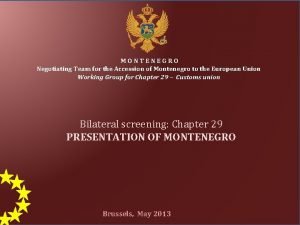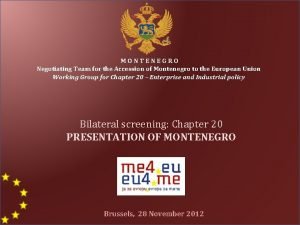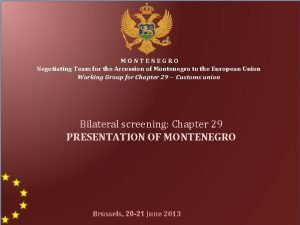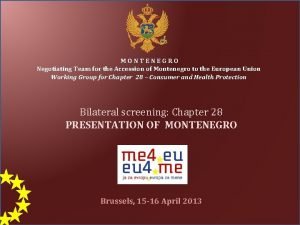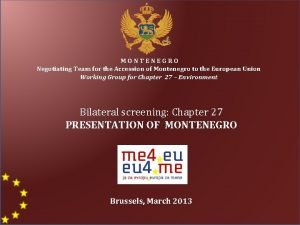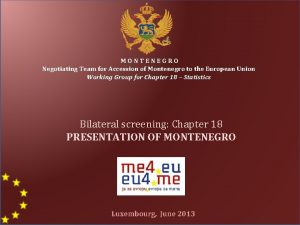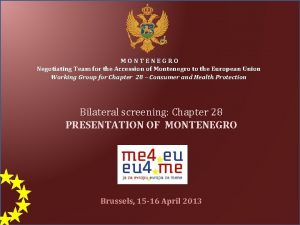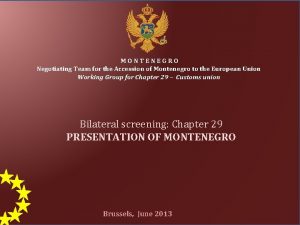MONTENEGRO Negotiating Team for the Accession of Montenegro

























- Slides: 25

MONTENEGRO Negotiating Team for the Accession of Montenegro to the European Union Working Group for Chapter 20 – Enterprise and Industrial policy Bilateral screening: Chapter 20 PRESENTATION OF MONTENEGRO Brussels, 28 November 2012

MONTENEGRO Negotiating Team for the Accession of Montenegro to the European Union Working Group for Chapter 20 – Enterprise and Industrial policy - Bilateral screening: Chapter 20 Presentation of Montenegro Brussels, 28 November 2012 Chapter Poglavlje 20: 25 Enterprise and Nauka Industrial i istraživanje policy

MONTENEGRO Negotiating Team for the Accession of Montenegro to the European Union Steel, metals and other sectors Dragan Kujović Deputy Minister Ministry of Economy dragan. kujovic@mek. gov. me Chapter Poglavlje 20: 25 Enterprise and Nauka Industrial i istraživanje policy

Chapter 20: Enterprise and Industrial policy I Manufacturing industry Ø Regardless of reduced contribution in the overall economic activity in Montenegro, industrial sector is still one of the most important economic sectors. Ø Changes in participation of overall industry over the past years didn’t significantly affected the industry to remain the largest and most important industry sector in Montenegro with remarkable significance for employment, GDP and export. Ø The average contribution of manufacturing industry to Montenegrin GDP in period 2000 -2005 was 10. 8%. In 2011 it was 5%. Ø Manufacturing industry sector employs approximately 15% of all registered employees, while it accounts for almost ¾ of the employment in the industry sector. Ø From total export in 2011, almost ½ is in sectors of non-ferrous metals 182, 4 mil €, steel and iron 27, 4 mil €) as the most important sectors within manufacturing industry. MONTENEGRO Negotiating Team for the Accession of Montenegro to the European Union Chapter 20: Enterprise and Industrial policy

Chapter 20: Enterprise and Industrial policy I Manufacturing industry Structure of physical volume of industrial production Extraction of mine and stone Manufacturing industry Supply of energy, gas and water 76. 4 67. 8 69. 9 71. 2 67. 9 67. 6 70 69. 2 62. 6 60. 1 51. 7 43. 1 33. 5 27. 5 24. 6 23. 3 26. 4 24. 9 21. 6 23. 8 23. 3 17. 3 12. 4 7. 6 2000 2001 6. 8 2002 7. 2 2003 7. 2 2004 6. 1 6 2005 2006 MONTENEGRO Negotiating Team for the Accession of Montenegro to the European Union 6. 2 2007 6. 3 2008 7. 5 3. 9 2009 2010 5. 2 2011 Chapter 20: Enterprise and Industrial policy

Chapter 20: Enterprise and Industrial policy I Manufacturing industry Ø At the end of 2011, manufacturing industry has recorded a growth rate of 6. 8% compared to previous year, owing this mostly to the increased production in sectorsof production of primary metals and metal products and processing of wood and wood-made products. Manufacturing industry growth rates in period 2002 -2011 113. 1 102. 3 109. 3 102. 5 97. 9 106. 8 100. 1 97 88. 7 61. 4 2002 2003 2004 2005 2006 2007 MONTENEGRO Negotiating Team for the Accession of Montenegro to the European Union 2008 2009 2010 2011 Chapter 20: Enterprise and Industrial policy

Chapter 20: Enterprise and Industrial policy I Structure of physical volume in manufacturing industry ØDifferent participation and contribution of sub-sector of the manufacturing industry in the overall results of the manufacturing industry, where sub-sector of basic metals and fabricated metal products has the largest share of 42% in 2011. The structure of physical volume of certain sectors in manufacturing industry Production of primary metals and metal products 90 80 Production of chemical products (including pharmaceutical industry) 70 60 50 Wood processing and wood-made products 40 30 Production of leather and leather items 20 10 0 2001 2002 2003 2004 2005 2006 2007 2008 2009 2010 2011 MONTENEGRO Negotiating Team for the Accession of Montenegro to the European Union Production of textile and textile items Chapter 20: Enterprise and Industrial policy

Chapter 20: Enterprise and Industrial policy I Contribution to the total value added manufacturing industry in 2011 Sectors of primary metals production, wood processing and processing of wood-made products, cork and reed; production of metal items, except machines and equipment and production of other products from metalloid minerals contributed in 2011 in overall value added with 10, 94%; 5, 00%; 9, 08% and 7, 92% respectively. MONTENEGRO Negotiating Team for the Accession of Montenegro to the European Union Chapter 20: Enterprise and Industrial policy

Chapter 20: Enterprise and Industrial policy II Steel and aluminium Ø Analysis the structure of manufacturing industry indicates that sector of production of primary metals and metal products remains the most significant sector of manufacturing industry, having contribution of 41. 78% in 2011. Ø From total export in 2011 almost ½ is in sector 6 -materials (non-ferrous metals 182, 4 mil €, steel and iron 27, 4 mil €) as the most important sectors within manufacturing industry. Share of the metal industry in manufacturing industry In production 42% In employment 21% In gross value added 11% Ø (The Steel Mill Nikšić)-Toscelik Alloyed Engineering Steel Nikšić Ø The Aluminium Plant (KAP) MONTENEGRO Negotiating Team for the Accession of Montenegro to the European Union Chapter. Poglavlje 20: 25 Enterprise and Nauka Industrial i istraživanje policy

Chapter 20: Enterprise and Industrial policy II Steel and aluminium Ø Toscelik Alloyed Engineering Steel Nikšić- (The Steel Mill Nikšić) § Production of steel since 1957 § Rolling mill since 1982 § Plant for cold wire rolling since 1992 § Capacity of 360 000 tons per year § New electric arc furnace and furnace dedusting system § Investments for the next five years: 35 million € Ø The Aluminium Plant (KAP) Podgorica § Production of aluminium since 1971 § Pechiney Technology § Capacity of 120 000 tones per year § Products: T-ingots, billets, slabs, trake, strips, wires, profiles, ropes § Production of alumina § Procurement of bauxite ore from Nikšić MONTENEGRO Negotiating Team for the Accession of Montenegro to the European Union Chapter Poglavlje 20: 25 Enterprise and Nauka Industrial i istraživanje policy

Chapter 20: Enterprise and Industrial policy II Steel and aluminium Potential characteristics for future development Ø Multiplicative influence on the development of industry and overall economy of Montenegro Ø High participation of this sector in the manufacturing industry and overall economy, employment and gross domestic product Ø Attractive export industry Ø Relatively highly accumulative industry Ø Special development opportunities for business cooperation (involvement in production chains) and joint investment (FDI) with foreign partners – companies from highly developed countries of the EU MONTENEGRO Negotiating Team for the Accession of Montenegro to the European Union Chapter Poglavlje 20: 25 Enterprise and Nauka Industrial i istraživanje policy

Chapter 20: Enterprise and Industrial policy II Steel and aluminium Fundamental directions for future development Ø Cooperation with higher education institutions and research centres; Ø Higher capacity utilization (without substantial investment) and growth of production; Ø Adaptation to dynamic market, technical-technological and organizational changes; Ø Launching of the complete “repro-chain” of the aluminium manufacturing sector with providing an adequate source of energy for the purpose of KAP; Ø Restructuring manufacturers towards the production which is competitive at the global level. MONTENEGRO Negotiating Team for the Accession of Montenegro to the European Union Chapter. Poglavlje 20: 25 Enterprise and Nauka Industrial i istraživanje policy

Chapter 20: Enterprise and Industrial policy II Steel and aluminium Development goals Competitiveness growth Profitability growth Investments in Prerequisite Revitalization and modernization • Sales revenue growth • Growth of labour productivity • • Market research Development Marketing Promotion • • Skilled labour force Modern machinery and equipment Automatization of production and control Improvements of the production process and quality of products • Basic facilities (liquid metal) • Processing capacities MONTENEGRO Negotiating Team for the Accession of Montenegro to the European Union Chapter Poglavlje 20: 25 Enterprise and Nauka Industrial i istraživanje policy

Chapter 20: Enterprise and Industrial policy III Minerals Ø In Montenegro around 28 types of minerals have been discovered, among them metallic, nonmetallic, energy minerals, etc. . The most significant minerals are coal, red bauxite, led and zinc Ø Significant impact on overall industrial development of Montenegro starting from the second half of 20 th century. Ø On the basis of exploitation of minerals such coal, red bauxite, sea salt, etc. . Montenegro has developed other processing industry (construction of thermal power plant, aluminium factory, salt processing plant), and therefore completed the reproduction chain. Ø During the previous decade, the Government has conducted ownership transformation of the industry, and therefore now all mining companies are privately owned, but State still has shares in two biggest mining company Ø Further development of mining, accompanied with adequate environmental protection and technological progress, by the means of attracting foreign investments, represents one of major priorities of Montenegro in the following period. MONTENEGRO Negotiating Team for the Accession of Montenegro to the European Union Chapter Poglavlje 20: 25 Enterprise and Nauka Industrial i istraživanje policy

Chapter 20: Enterprise and Industrial policy III Minerals Mineral reserves in Montenegro* type coal (lignite) coal (brown) bauxite led and zinc proven geological reserves 198. 936. 598 13. 241. 382 21. 466. 839 20. 664. 497 *in million of tones MONTENEGRO Negotiating Team for the Accession of Montenegro to the European Union Chapter Poglavlje 20: 25 Enterprise and Nauka Industrial i istraživanje policy

Chapter 20: Enterprise and Industrial policy III Minerals Coal, bauxite, lead and zinc Ø Two major coal deposits Pljevlja and Maoče are located in the north of the country; Ø The State of Montenegro owns 31. 1117% of shares in the total equity of the Pljevlja Coal Mine Joint Stock Company which exploits Pljevlja basin from 1952; Ø Most of the production of the Pljevlja Coal Mine, as it is defined under the concession contract, is used for the purpose of the Thermal Power Plant Pljevlja operation; Ø Maoče basin is most significant and the largest natural mineral resource deposit discovered to-date in Montenegro with prove exploitation reserves of 109 900 000 tones; Ø Red bauxite is one of the most prominent mineral resources in Montenegro, both in terms of abundance and economic value. MONTENEGRO Negotiating Team for the Accession of Montenegro to the European Union Chapter Poglavlje 20: 25 Enterprise and Nauka Industrial i istraživanje policy

Chapter 20: Enterprise and Industrial policy III Minerals Coal, bauxite, led and zinc Ø The only concession right to exploit red bauxite ore in Montenegro belongs to the Bauxite Mines Niksic Joint Stock Company, which 33% shares are owned by the State. Ø Most of the production of the red bauxite it is used for the supply of the Aluminium Plant (KAP) Ø Suplja Stijena and Brskovo are two discovered deposits of lead and zinc in the Montenegro Ø Deposit Suplja Stijena is under exploitation by Montenegrin company Gradir Montenegro, which is owned by the Polish state company ZGH Boleslav Ø Deposit Brskovo is phase of geological exploration and concession is awarded to Montenegrin company North Mining, which is owned by the Australian mine company Balamara MONTENEGRO Negotiating Team for the Accession of Montenegro to the European Union Chapter Poglavlje 20: 25 Enterprise and Nauka Industrial i istraživanje policy

Chapter 20: Enterprise and Industrial policy IV Wood industry Ø Wood indutry is an important segment of the economy of Montenegro and its development is based on the use of local natural resources and it is traditionally export-oriented. Ø Raw material resources and capacities represent a good basis for much higher level of production, as well as a significant share in total GDP, export and employment. Ø The structure of today's wood industry production consists of: 1. Primary production (production of lumber and elements), 2. Secondary production (pallets and elements for pallets with the production of briquettes), 3. Final production (production of furniture, parquet flooring, prefabricated wooden houses, latex strips, joinery (doors and windows)). Ø Today's wood industry sector is made up of 90% of primary and secondary production and 10% of the final production. MONTENEGRO Negotiating Team for the Accession of Montenegro to the European Union Chapter Poglavlje 20: 25 Enterprise and Nauka Industrial i istraživanje policy

Chapter 20: Enterprise and Industrial policy IV Wood industry Ø The generally defined long-term goal is: wood processing and furniture production as economically successful, profitable business activities with a balanced, competitive and sustainable development, following the global development trends. The goal is based on the assumption of increased economic efficiency, and raising competitiveness will be a key point for continuous economic achievements. Number of employees (2011) 1999 (13. 9% of total employees in manufacturing industry) Number of companies (2011) 344 (20. 1% of total companies in manufacturing industry) The import of products made of wood, paper, printing and furniture (mil €) The export of wood, paper, printing and furniture (milion €) 180. 9 24 121. 4 2008 2009 120. 2 2010 117. 1 2011 MONTENEGRO Negotiating Team for the Accession of Montenegro to the European Union 19. 9 2008 18. 4 2009 20. 7 2010 2011 Chapter Poglavlje 20: 25 Enterprise and Nauka Industrial i istraživanje policy

Chapter 20: Enterprise and Industrial policy IV Wood industry Ø One of the most important goals in the coming period should be an increase in the number of companies whose production programmes and business plans are based on final production, development and placement of high-value products, an increase in the production volume and quality of export products. Increase the participation and competitiveness of final products on the domestic and foreign markets Development goals Encourage the development and protection of the wood processing and furniture production industry, without prejudice to its openness Increase employment with ensuring the retention of population in the areas with rich raw material resources MONTENEGRO Negotiating Team for the Accession of Montenegro to the European Union Chapter Poglavlje 20: 25 Enterprise and Nauka Industrial i istraživanje policy

Chapter 20: Enterprise and Industrial policy V Textile, clothing, footwear and chemicals -Participation of certain sectors in total industryØ Except pharmaceutical industry, these industrial sub-sectors have recorded a downfall in production in previous years. Ø High dependence from import, difficulties in providing raw materials and placement of finished products with reduced competitiveness on domestic and foreign market. 9 8 Production of textile and textile items 7 Production of clothes and furs 6 Production of leather and leather items 5 4 Production of chemical products 3 Production of pharmaceutical products 2 Production of rubber and plastic products 1 0 2007 2008 2009 2010 MONTENEGRO Negotiating Team for the Accession of Montenegro to the European Union 2011 Chapter Poglavlje 20: 25 Enterprise and Nauka Industrial i istraživanje policy

Chapter 20: Enterprise and Industrial policy V Textile, clothing, footwear and chemicals Ø Textile sector in the past ten years has been shrink to less than one tenth of what it used to be at the beginning of 2000. Similar trends are recorded in some other sectors such as leather and footwear sectors or graphic and paper sectors which have lost the capacities they had at the beginning of 2000. Ø Primary production doesn’t exist or it’s very low and most of the production is based on the clothing industry. Ø Sector of production of chemical products and fibers with pharmaceutical industry has recorded growth of contribution from 2, 80% in 2001 to 15, 67% in 2011, while chemical sector only has recorded downfall with share of 0, 2% in industrial production. Ø Evident trend of import growth The import of clothing in 2011. (total 48. 8 mil €) EU Other countries 23% 77% The import of chemical products (including pharmaceutical industry) in 2011. (total 81. 5 mil €) EU Other countries The import of footwear in 2011. (total 27. 2 mil €) EU Other countries 22% 15% 85% MONTENEGRO Negotiating Team for the Accession of Montenegro to the European Union 78% Chapter Poglavlje 20: 25 Enterprise and Nauka Industrial i istraživanje policy

Chapter 20: Enterprise and Industrial policy V Textile, clothing, footwear legislation Ø Transposition of the EU legislation on textile and clothing into montenegrin legislation On the basis of Law on technical requirements for products and conformity assessment (‘’Official Gazette MNE, 53/11’’) it will be prepared Rulebook that will traspose EU Regulation 1007/2011 into national legislation by creation of Rulebook in the area of textile. Ø Transposition of the EU legislation on footwear into montenegrin legislation On the basis of Law on technical requirements for products and conformity assessment (‘’Official Gazette MNE, 53/11’’) it will be prepared Rulebook that will transpose EU Directive 94/11 into national legislation by creation of Rulebook of footwear. MONTENEGRO Negotiating Team for the Accession of Montenegro to the European Union Chapter Poglavlje 20: 25 Enterprise and Nauka Industrial i istraživanje policy

Chapter 20: Enterprise and Industrial policy Further steps Ø Within IPA 2008, BESRE project, it has been prepared Draft of Montenegrin Industrial Development Strategy Document, addresses two key industrial sectors, steel industry and wood processing industry, as the most promising industrial sectors of Montenegrin economy Ø Finalisation of Strategy MONTENEGRO Negotiating Team for the Accession of Montenegro to the European Union Chapter Poglavlje 20: 25 Enterprise and Nauka Industrial i istraživanje policy

Thank you for your attention! QUESTIONS
 Rhs & seba
Rhs & seba New accession training navy
New accession training navy Eva hesse latex
Eva hesse latex Ipa instrument for pre-accession assistance
Ipa instrument for pre-accession assistance Allintitle accession à la propriété
Allintitle accession à la propriété Uncontrolled railroad crossings usually have ______.
Uncontrolled railroad crossings usually have ______. Chapter 7 negotiating intersections
Chapter 7 negotiating intersections Chapter 10 negotiating intersections
Chapter 10 negotiating intersections Weiss’ strategic framework for negotiating
Weiss’ strategic framework for negotiating Pooled negotiating power
Pooled negotiating power Sap licensing negotiation
Sap licensing negotiation Pooled negotiating power
Pooled negotiating power The sign for an uncontrolled railroad crossing is a
The sign for an uncontrolled railroad crossing is a An uncontrolled railroad crossing usually has a
An uncontrolled railroad crossing usually has a Slide 6/21
Slide 6/21 The white team cheers for the blue team, just like
The white team cheers for the blue team, just like Team spirit becomes team infatuation
Team spirit becomes team infatuation Team spirit becomes team infatuation
Team spirit becomes team infatuation Montenegro
Montenegro Hilton hotel montenegro
Hilton hotel montenegro Montenegro pealinn
Montenegro pealinn Filo sarcomastigophora
Filo sarcomastigophora Ministry of interior montenegro
Ministry of interior montenegro Montenegro university
Montenegro university Oswaldo montenegro a lista
Oswaldo montenegro a lista Language in montenegro
Language in montenegro



